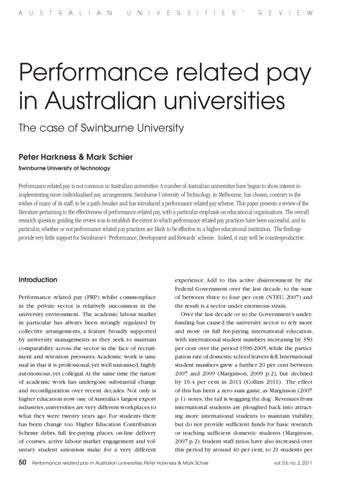A
U
S
T
R
A
L
I
A
N
U
N
I
V
E
R
S
I
T
I
E
S
’
R
E
V
I
E
W
Performance related pay in Australian universities The case of Swinburne University Peter Harkness & Mark Schier Swinburne University of Technology
Performance related pay is not common in Australian universities. A number of Australian universities have begun to show interest in implementing more individualised pay arrangements. Swinburne University of Technology, in Melbourne, has chosen, contrary to the wishes of many of its staff, to be a path-breaker and has introduced a performance related pay scheme. This paper presents a review of the literature pertaining to the effectiveness of performance-related pay, with a particular emphasis on educational organisations. The overall research question guiding the review was to establish the extent to which performance related pay practices have been successful, and in particular, whether or not performance related pay practices are likely to be effective in a higher educational institution. The findings provide very little support for Swinburne’s ‘Performance, Development and Rewards’ scheme. Indeed, it may well be counterproductive.
Introduction Performance related pay (PRP) whilst commonplace in the private sector, is relatively uncommon in the university environment. The academic labour market in particular has always been strongly regulated by collective arrangements, a feature broadly supported by university managements as they seek to maintain comparability across the sector in the face of recruitment and retention pressures. Academic work is unusual in that it is professional, yet well unionised, highly autonomous, yet collegial. At the same time the nature of academic work has undergone substantial change and reconfiguration over recent decades. Not only is higher education now one of Australia’s largest export industries, universities are very different workplaces to what they were twenty years ago. For students there has been change too. Higher Education Contribution Scheme debts, full fee-paying places, on-line delivery of courses, active labour market engagement and voluntary student unionism make for a very different
50
experience. Add to this active disinvestment by the Federal Government over the last decade, to the tune of between three to four per cent (NTEU, 2007) and the result is a sector under enormous strain. Over the last decade or so the Government’s underfunding has caused the university sector to rely more and more on full fee-paying international education, with international student numbers increasing by 350 per cent over the period 1996-2005, while the participation rate of domestic school leavers fell. International student numbers grew a further 20 per cent between 2007 and 2009 (Marginson, 2009 p.2), but declined by 16.4 per cent in 2011 (Collins 2011). The effect of this has been a zero sum game, as Marginson (2007 p.1) notes,‘the tail is wagging the dog’. Revenues from international students are ploughed back into attracting more international students to maintain viability, but do not provide sufficient funds for basic research or teaching sufficient domestic students (Marginson, 2007 p.2). Student staff ratios have also increased over this period by around 40 per cent, to 21 students per
Performance related pay in Australian universities, Peter Harkness & Mark Schier
vol. 53, no. 2, 2011
